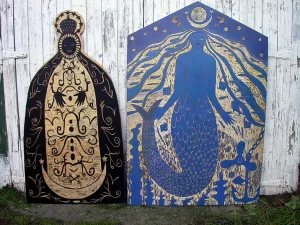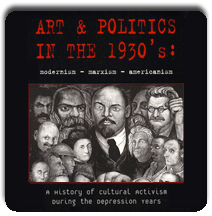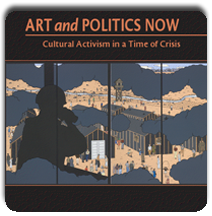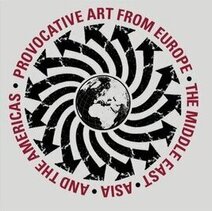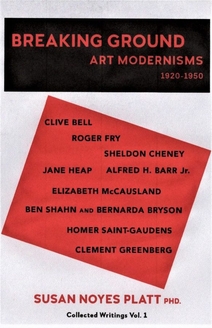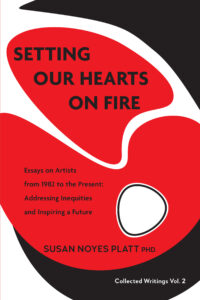Subversion: The Art of Slavery Abolitionism
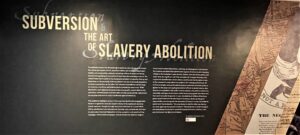
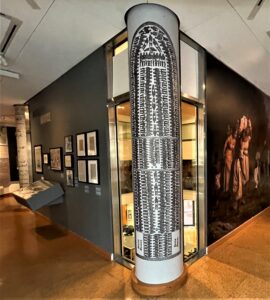
We saw this provocative exhibition “Subversion and the Art of Slavery Abolition,” at the Schomburg Library for Research in Black Culture in Harlem, when we stayed there last week.
Curated by Dr. Michelle Commander, Associate Director and Curator of the Lapidus Center for the Historical Analysis of Transatlantic Slavery, it is an astonishing work of research in the New York Public Library archives.
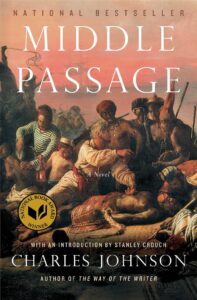
As it happens, I am immersed myself in the theme of black creativity in the US as I am reading Charles Johnson’s astonishing book
The Middle Passage, which, it seems to me, is a type of partner to Moby Dick. Johnson details the realities of a slave ship in horrifying detail with a narrator, Rutherford Calhoun, who tells all. Moby Dick of course was focused on the horrors of the whaling industry and only mentions passing slave ships in the sea. all narrated by
Ismael, a sole suvivor of the disaster.
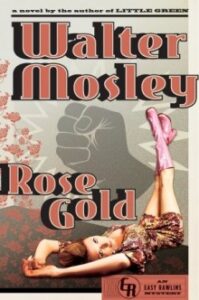
At the same time, I am also reading a novel by Walter Moseley, brilliant writer of “gum shoe” detective stories that are much more a commentary on black life in America ( in this case 1970s ). His descriptions of many many skin colors alone is worth reading, but of course, the pervasive violence against blacks by the police is a dominating theme. Easy Rawlins is the hero, outsider, renegade private detective survivor in 12 novels by Moseley over thirty years.
On this same trip to New York City we also saw Carrie Mae Weems exhibition, about which I will write separately, as well as a contemporary artist, Leonardo Bezant 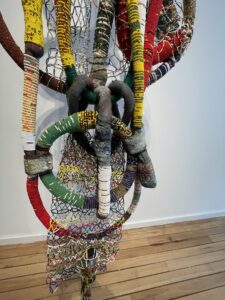
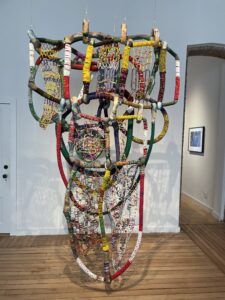 at the Claire Oliver Gallery in Harlem.
at the Claire Oliver Gallery in Harlem.
“Reliquary For The Black Boy Who Sits At The Window Dreaming(A Collection Of Conjurings and Letters)”
incredibly intricate work with beads with several metaphorical layers.
In addition I am reading “The Matter of Black Lives” compiled by Jelani Cobb and David Remnick , New Yorker articles over decades on Black life in America.
So this exhibition at the Schomburg was extremely timely for me to see. All of the works are in the public domain on the website for the NYPL. The credit for all of them includes Photographs and Prints Division. Schomburg Center for Research in Black Culture, The New York Public Library, Astor, Lenox and Tilden, but I will only include the collection in the caption, which is an intriguing study in itself.
I am simply quoting from Dr. Commander in the text of this post. I am not able to rephrase or paraphrase her ideas. That means it is a bit long, and wordy, but worth reading. Also worth going to the website where every single one of the art works are reproduced.
(there is also an audio tour of the exhibition on the website that goes into the imagery and the topics) :
Dr. Commander introduces the exhibition with the following statement
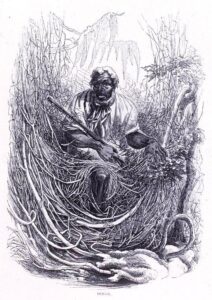
Osman the Maroon in the Swamp 1857 Slavery Collection
“Transatlantic slavery was devastatingly brutal in its utter disregard for human life. Across the Atlantic World, avaricious traders and enslavers ripped apart families and communities, callously murdering millions of people of African descent and legalizing the extraction of labor from the unwitting survivors. The United States was founded on the inalienable principles of equality, liberty, and democracy on the one hand, while the nation’s rise was enormously dependent on slavery speculation on the other. This inherent contradiction set the stage for centuries of political and philosophical conversations and unrest. While slaveholders and vigilantes threatened and attempted to control Black bodily autonomy, enslaved people and their allies artfully countered this malevolence via everyday and more formally coordinated types of resistance.
This exhibition highlights several of the ways that abolitionists engaged with the arts to agitate for enslaved people’s liberty in the eighteenth and nineteenth centuries. Though the major focus is on American (U.S.) and British efforts, abolitionism was transnational, dynamic, and controversial.
Anti-slavery advocates immersed themselves in letter, pamphlet, and speech writing campaigns and founded newspapers, despite known and unknown dangers. Visual artists created illustrations, paintings, and photographs that featured the mundane yet absolutely reprehensible aspects of slavery to alert everyday citizens to the institution’s many horrors.
Novels, slave narratives, poetry, and music were also significant and often encoded with insurgent messages that inspired the establishment of anti-slavery societies and the formation of one of the movement’s most subversive projects: The Underground Railroad.
All of these strategies were profoundly necessary as activists rallied the public to agitate for the cause and urged governmental officials to abolish slavery. Abolitionist arts appealed to the public’s moral, religious, and political convictions, eventually yielding a robust stream of anti-slavery propaganda and radical acts that could not easily be ignored.
In 1791, the abolitionist William Wilberforce gave a speech before the British House of Commons, declaring that great responsibility came along with the awareness of slavery’s cruelty. He ended his speech with the declaration, “You may choose to look the other way but you can never again say that you did not know.” This sentiment no doubt energized and emboldened abolitionists’ incredible displays of bravery, intellect, craft, and artfulness in the fight to end slavery.”
She divided the exhibition into six themes
1 Brutality and Avarice
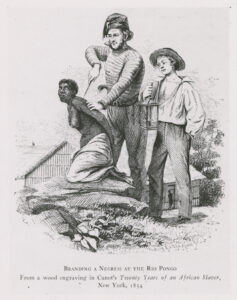
Slave Traders Branding an African Woman Creation: 1854 Slave Traders Branding an African Woman at the Rio Pongo (in Guinea, West Africa) Taken from “Captain Canot, Twenty Years of an African Slaver” Punishment and Torture Sub-Collection, Slavery Collection
“The items in this section have been selected to show the early roots of capitalist avarice/greed in the Atlantic World. The items not only highlight that slavery was seen as an everyday business in its accounting practices and uses of brutality to keep enslaved people in their places, but also gives a sense of the racist philosophies that maintained and even used the Bible to rationalize the “need” for the institution.”
2 Resistance and Rebellion
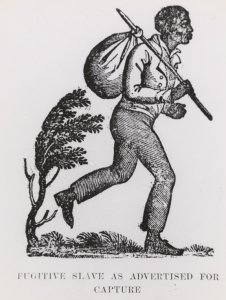
Fugitive Slave as Advertised for Capture 1857 Fugitive Slave as Advertised for Capture Fugitive Slaves Collection
“This exhibition begins with examples of enslaved people’s resistance and rebellion. Their actions– running away, fighting back on slave ships and in the Atlantic World, establishing maroon communities– most shocked and alerted the world to the injustices and inhumanity of the slave trade and slavery as it existed across the Atlantic World.
It should be noted that abolitionists argued mightily over the use of violence and force. Some felt that fighting back and being otherwise belligerent in everyday interactions would only support enslavers and other pro-slavery individuals’ arguments that slavery was beneficial because it tamed and educated so-called “primitive” people of African descent.
Smaller forms of resistance, too, were important as they kept enslavers on their toes and gave enslaved people some sense of power and control over their lives.”
3 Abolitionism
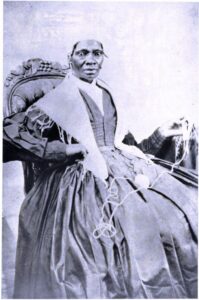
Sojourner Truth Photographer Unknown Circa 1860s
“Art denotes strategy, ingenuity, and imagination. Abolitionists of all stripes participated in the cause, prompted firstly by the refusal of African captives to abide slavery’s many violences. Enslaved people worked slowly, fought back, and set plantations aflame, giving pause to enslavers. They fellowshipped with one another and created kinship networks, despite all efforts to break their spirits and resolve to live and love. Self-liberated fugitives from slavery banded together as well as with freepersons to establish maroon, mocambo, and quilombo settlements in hills, valleys, swamps, and mountains. As instances of insurrection intensified on ships in the Middle Passage and across the Atlantic World, objections to the institution of slavery by social reformers and everyday citizens also increased, reaching fever pitch by a diversity of anti-slavery proponents in the nineteenth century.”
“Sojourner Truth (1797–1883) was born enslaved in Ulster County, New York. In 1826, she escaped the bonds of slavery with her infant daughter in tow and successfully sued to gain custody of her minor son. She later became an outspoken abolitionist and suffragist, giving the famous address known as the “Ain’t I a Woman” speech in 1851 before the Ohio Women’s Rights Convention in Akron, Ohio.”
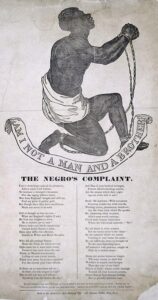
The Negros Complaint 1870 Slavery Collection
4 Poetics and Music
“Abolition-minded poetry and music got to the heart of the matter using few lyrics, generally. Poetry and musical lyrics were printed in collections as well as re-published as complements to essays and speeches in anti-slavery newspapers, almanacs, and children’s books. They were also printed and sold as broadsides at anti-slavery meetings and other events. The items in this section include those that take on the persona of enslaved individuals to address their inner turmoil and longings. Other pieces recount the everyday horrors with which the enslaved were forced to contend from the Middle Passage to the plantation.”
5 Narratives of Fugivity & Fidelity
“The items in this section include several fugitive slave narratives, anti-slavery fiction (Harriet Beecher Stowe’s Uncle Tom’s Cabin), and the ways that Black loyalty to the nation was encouraged and expressed through participation in the Civil War. Narratives of enslavement were important to the cause of abolitionism because they offered first-hand accounts of the many horrors of the institution. These narratives appealed to the sympathies of white Northern men and women, with the texts that were written by men very much reflecting on honor and manhood. Women’s narratives often delved into sentimentalism and the authors’ affective experiences as a mother and/or wife, which were feelings that women of the time, regardless of their backgrounds, might be emotionally moved by. These narratives also revealed a sense of enslaved communities’ cultures and beliefs, the restrictions that were placed upon enslaved people, the violence that undergirded slavery, as well as some of the artful ways that enslaved people resisted, banded together, and escaped their enslavement.”
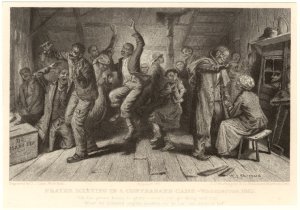
Prayer Meeting in a Contraband Camp 1887 Prayer Meeting in a Contraband Camp, Washington, 1862 William Ludwell Sheppard
“Encampments that were established near Union forces during the American Civil War by liberated enslaved people. This prayer meeting portrays its attendees worshipping charismatically. They are fellowshipping, singing, clapping, and dancing with one another perhaps in celebration or, at the very least, in hopes that liberation—worldly or heavenly—was truly to come”
6 Anti-Slavery Children’s Primers
“Abolitionists did not forget the very impressionable new generation. Within many larger publications (almanacs, newspapers, and other periodicals), there was a children’s section to help groom an abolitionist future. The Slave’s Friend is one example of a publication that was dedicated solely to children. Authors also wrote children’s books on slavery and various versions of the alphabet of slavery to appeal to children as well as to assist parents and other adults as they broached the difficult topic with youth. This section also includes an image of The New York African Free School, a critique of Harriet Beecher Stowe’s representations of Black children in her anti-slavery novel Uncle Tom’s Cabin, and the Nautilus Life Insurance companies death ledger, containing the records of enslaved people.”
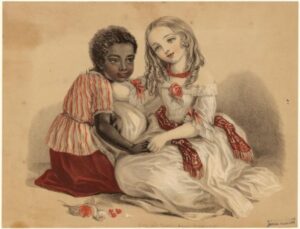
Eva and Topsy Creation: Circa 1860s Harriet Beecher Stowe Lithograph
“Eva and Topsy, major characters from Harriet Beecher Stowe’s anti-slavery novel Uncle Tom’s Cabin, are shown here in an affectionate pose. Throughout the novel, however, Topsy is portrayed most memorably as a naughty “pickaninny” who needs corrective whippings and consistent instruction to behave because she has no family and simply does not know better.
While some readers felt a moral dilemma about slavery as they read about Topsy’s behavioral struggles, others found that this storyline was evidence that slavery had a good overall effect on improving what they viewed as inherent Black pathology. Like many of Stowe’s other presumably well-intentioned, though exceedingly stereotypical characters, derogatory minstrel shows featured the Topsy character to poke fun at the intellect of Black people. As Stowe discovered from the backlash she received from abolitionists, literary and visual representations of Black people were and remain political.”
Each theme has detailed information sometimes tracts, sometimes books, photographs, prints. You can see them all on the website. Scroll down to the online gallery.
Seeing this exhibition at this time of so much new awareness of racism in the US both past and very much present gives us an appreciation of the huge power of resistance in creative expressions. Collectively these tracts, images, poems, songs, photographs, tell us the power of the human spirit to resist unspeakable brutality.
This entry was posted on January 2, 2022 and is filed under Abolitionism, Art and Politics Now, Uncategorized.
Morgan Peterson on Greed, Power, Control and Murder
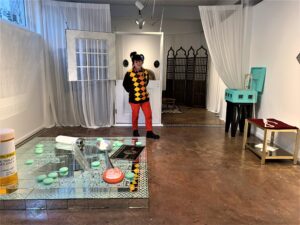
“Born of our Culture: American Excess” a recent installation at Method Gallery by Morgan Peterson tells it like it is in our contemporary moment. Morgan Petersen has long been fascinated by true crime and the amplifying role that media plays in our culture starting with the 1969 Charles Manson murders
My fascination with true crime began as a small child reading about the Tate/Labianca murders committed by the Manson Family Cult late in the evening on August 8,1969. This installation mirrors events that transpired that evening which captured the attention of the world as they unfolded while revealing the driving forces of racial discrimination and profiling that repeat throughout history.
She interweaves references to media hyped events with her commentary on the American culture of Excess. It could not be more timely in the age of the insanely overpriced and climate destroying NFT and bitcoins.
The exhibition actually consists of three interrelated installations:
we first see a giant reflective glass surface with oversized components of drugs and their use referencing the opioid epidemic. A huge bottle of oxycontin makes it hard to miss the point. Here is
Once Upon A Crime, The American Epidemic
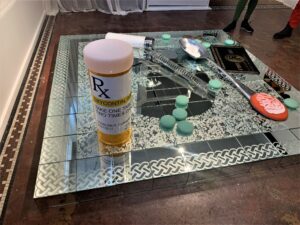
The epidemic is based in greed:
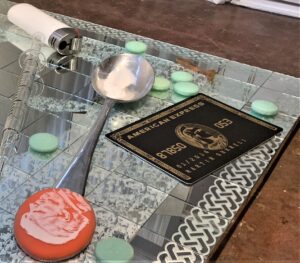
the installation specifically references Martin Shkreli on the credit card who raised the price of life saving drugs from 13. to 750. per pill.
Peterson also comments on excess more subtly in the pattern of the glass surface. It is based on the cover of an album which the artist describes as “the most expensive album ever sold, Once Upon A Time In Shaolin . . . This piece speaks of the overreaching power in politics, being born with a silver spoon in your mouth, the opioid epidemic and all over corruption.”
A second installation features Black Panther leader Huey P. Newton’s iconic Emmanuel chair.
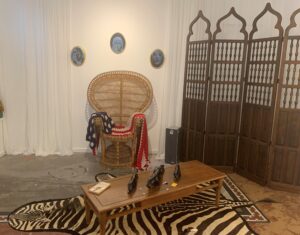
It refers to Black Panther Fred Hampton’s horrific murder by police just after Charles Manson’s effort to link Black Panthers to multiple murders by his cult members in 1969 in order to start a race riot. The Charles Manson cult murders of Sharon Tate, Jay Sebring, Abigail Folger, Wojciech Frykowski, Steven Parent, Leno and Rosemary LaBianca were followed shortly after by Fred Hampton’s assassination by the police, and twenty years later by Newton’s murder.
Newton and Hampton were both brilliant founders and spokespersons for the Black Panthers. Their programs such as “giving breakfast to children and creating alliances among street gangs, food banks, medical clinics, sickle cell anemia tests, prison busing for families of inmates, legal advice seminars, clothing banks, housing cooperatives, and their own ambulance service” were incredibly successful which is why the FBI decided they were terrorists. They were disrupting the capitalist machine and the racist oppressions that keep it running.
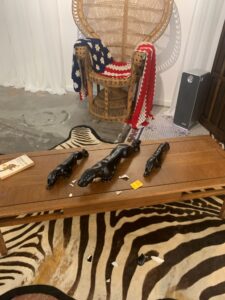
Morgan Peterson honors their deaths with this installation which includes specific vintage furniture and props from the 1960s that she carefully located. On the coffee table you see a book and matchbox precisely recreating the scene of the murder of Hampton. The stone sculptures of the Black Panthers suggest by their small scale, the oppression of our dominant gaze
A third installation refers to our very present moment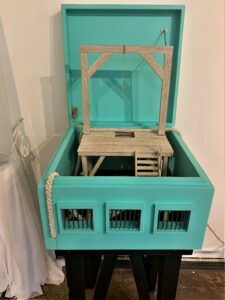

This carefully constructed wooden gallows with its lynch noose made of 11000 small pearls woven by the artist in a special Russian spiral stitch, speaks for itself. The horror of our January 6 attempted coup, as well as the role of greed in racism in our country is spelled out here.
( The artist bought the pearls with the stimulus check from the government during the pandemic. She made the work in collaboration with wood working master Alexander Pope.)
Peterson speaks to the current insanity of our country, the thirst for power at all costs.
Peterson was trained as a glass artist, and glass is prominent in several elements of the exhibition. But these glass works move way beyond any traditional idea of glass. The simplicity and familiarity of the material belies the complexity of the technique needed to create art with it and as a material that can speak to political issues.
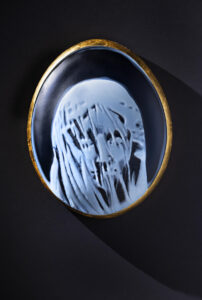
Photo Credit Russell Johnson
Above the Emmanuel Chair are three glass engraved cameos, two are portraits of people murdered by Manson.
Morgan honors these people with so called cameo “mourning portraits.” The third cameo is a specific image of mourning, a quote from a sculpture of a veiled virgin.
Cameos are demanding to create: they are based on reductively carving away a glass layer to reveal what is underneath.
Paula Stokes, a founder of Method gallery, suggests in a fascinating interview with Peterson that carving away of the surface reveals imagery underneath that can become sinister.
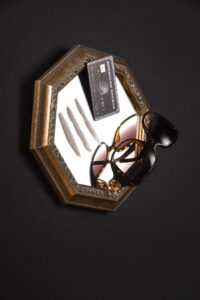
One other group of works in the exhibitions using mirrors and various luxury accouterments refer to cocaine use by the wealthy.
The intertwining of the rich use of cocaine, the opioid epidemic, and the overpricing of life saving drugs, lead directly to the pearl encrusted noose held in the hands of those in power to entrap and destroy the powerless.
The Black Panthers were taking power from the ruling class and therefore had to be stopped. We can draw a straight line from them to the present moment.
Embedded in both history and the present moment, “Born of our Culture: American Excess” suggests the true state of our world, in the massive disparity between the practices of those who control power and will murder those who threaten it, and those who seek simply to survive day to day.
As Ann Applebaum wrote in a recent article in the Atlantic, “The Bad Guys are Winning,” the big shift is the level of impunity with which the wealthy now operate. Autocracy operates across national lines and with absolute disregard for the well being of individuals.
Also explaining the depth of our problem is Sarah Chayes book
On Corruption in America and What is At Stake.
Chayes speaks of the many headed Hydra of greed , when you cut off one head another grows, and she traces greed in her book all the way back with Midas. She and Applebaum both point to the intersections of autocracies and kleptocracies, as a network that ensures their own survival above all else.
Likewise Morgan Peterson addresses the hydra of greed is this compelling group of installations. But she connects the dots right to the racism that underlies greed, as well as its outcome in assassination and lynching.
This entry was posted on December 3, 2021 and is filed under Art and Politics Now, Contemporary Art, Uncategorized.
Ghost of a Dream and Elizabeth ‘Mumbet’ Freeman
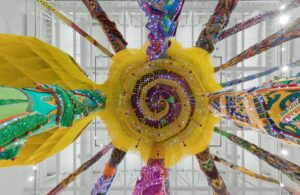
“Any time, any time while I was a slave, if one minute’s freedom had been offered to me, and I had been told that I must die at the end of that minute, I would have taken it, just to stand one minute on God’s earth a free woman, I would.” Elizabeth “Mumbet” Freeman
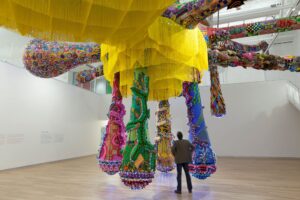
Joana Vasconcelos, “Valkyrie Mumbet,” 2020, 384 x 672 x 504”,Stephen D. Paine Gallery all photos of Valkyrie by Will Howcroft. Courtesy MassArt
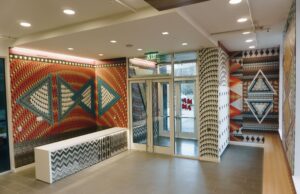
Ghost of a Dream, “Yesterday Is Here”, through December, 2021
Gudrun Arsaelsdorrit Edelsten and Lynn Puritz Warner Lobby all photogs of Yesterday is Here by Daniel Berube ’21.
Courtesy MassArt. (3)
Installation views at MassArt Art Museum, Massachusetts College of Art and Design, Boston, MA
I have once again invited my good friend in Boston, Pamela Allara. to provide a post! The shows are up until the end of December.
The gallery at Massachusetts College of Design in Boston has always held innovative exhibitions, but in an inadequate space that frequently dulled its impact. In February, 2020, MassArt Art Museum,(MAAM) held a grand opening for its new gallery, a large, airy, two-story space with its very own entrance for the first time! Unfortunately, March, 2020 followed closely thereafter, and the beautiful space has been closed until its recent re-opening on October 9.
Don’t miss the two exciting exhibits now open, one in the lobby/reception area and the other in the main space. They are well worth a visit both for their intrinsic aesthetic value and for the introduction they provide to the work of less familiar artists.
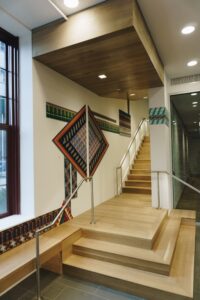
Ghost of a Dream is an artists’ collective based in Wassaic, New York. Led by Adam Eckstrom, GoaD sponsors Art for Artists (www.artforartists.org), an invitational, curated art exchange, as well as an ‘edition exchange’ which includes works for sale. (The latter have been donated to the Southern Poverty Law Center and elsewhere).The collective makes works from ephemera that center, in their words, “on people’s hopes and dreams.”
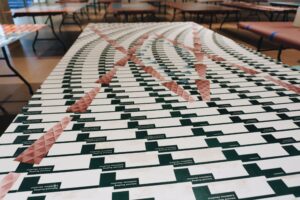
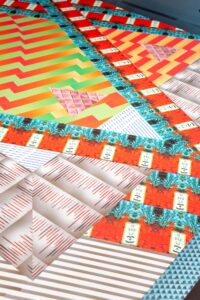
As the MAAM looks to the future, GoaD reminded visitors that the new exhibition program should not entail leaving the past behind. On the lobby’s walls they installed a collage created from cut-up and spliced-together images from over 30 years of MAAM’s exhibit catalogs and announcements. Combined into geometric patterns on the wall, they created a handsome, site-specific installation, “Yesterday Is Here,” that caused the viewer to pause and acknowledge the important work the gallery has done before seeing the new work in the main space.
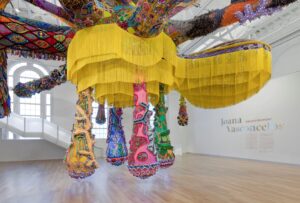
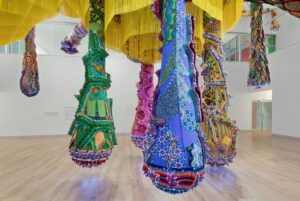
The multi-media work installed upstairs, “Valkyrie Mumbet,” is both monumental and intimate. Its tentacles spanning the entire two-story gallery almost like a giant octopus, it might have been threatening if it were not apparent that the delicate artwork had been constructed out of crochet, embroidery and fabrics, including capulanas from Mozambique, where the artist’s parents grew up. Also known as African wax print or Dutch Wax cloth, European traders mass-produced and profited from capulanas, but more recently they have been reclaimed by local designers in Mozambique. As the exhibit label points out, the cloths “…exemplify the fluidity of cultures and reflect a complicated and intertwined history of cultural exchanges across continents, as well as the legacy of European exploitation, colonization, and slaveholding.”

Vasconcelos is among a number of contemporary artists using fabric and crocheted cloths in their work to reference culture and history: Ernesto Neto, Ibrahim Mahama, Nick Cave and Olafur Eliasson, among others.
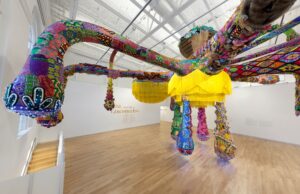
When the gallery, which is on the second floor of the building, was renovated, the 1906 steel vaulting and girders were exposed, which allows artwork to be suspended from the ceiling, as in this instance. From below, “Valkyrie Mumbet” seems to float, increasing the sense of its delicacy.

As we approach for a closer look at the ‘tentacles,’ the variety of the swatches of hand-embroidered and crocheted fabrics remind us of the history of women’s craft work, undervalued for its historical and aesthetic significance until recently. Clearly these fabrics have stories to tell us, but what are they? It will be important to read the label more carefully than usual. So much for skimming!
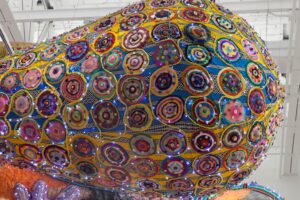
The work is part of Vasconcelos’ ongoing Valkyries series, which honors inspiring women and has been shown at the Venice Biennale and other prominent venues.
Surprisingly, this is the first U.S. exhibit of any of her multi-media work. When she was approached by Lisa Tung, Executive Director and curator at MAAM to create a site-specific installation, Vasconcelos requested information about notable women from Boston’s history.
According to the account of the staff they provided her with
“a list of individuals whose legacies include suffrage, poetry, charity, cycling, nursing, and activism among others. Vasconcelos was strongly drawn to Elizabeth “Mumbet” Freeman’s story and wanted to honor her. This monumental installation is the artist’s own distinctive homage to Freeman”
Elizabeth “Mumbet” Freeman, was an enslaved woman who in 1781 sued the state under the Massachusetts’ Constitution’s Bill of Rights, which stated that “all men are born free and equal.” Between 1764 and 1780, 30 enslaved people had sued for their freedom citing the Constitution, but Freeman was the first to sue under a ‘natural right to freedom.’ Despite the fact that slavery was still legal in Massachusetts, and moreover, “men” meant white men, she won her suit and was freed.
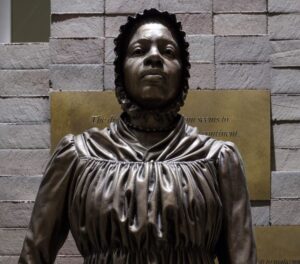
Subsequently, she purchased a home in Stockbridge, MA, where she lived comfortably until her death in 1829. Her eloquent statement explaining the reason for her suit is memorable: “Any time, any time while I was a slave, if one minute’s freedom had been offered to me, and I had been told that I must die at the end of that minute, I would have taken it, just to stand one minute on God’s earth a free woman, I would.”

Given the context, the fact that the work floats rather than being adhered to the flooring, and that the tentacles reach out and up, even to the second-floor balcony, underscores the theme of seeking freedom. Again, in that context, each patch of fabric or handwork becomes the record of an enslaved individual, part of their clothing or of cloths used for cleaning, as well as fabric referencing colonial histories. History is made concrete.
This entry was posted on November 11, 2021 and is filed under Art and Activism, Art and Politics Now, art criticism, Contemporary Art, Feminism, Uncategorized.
Youth Climate March in Seattle October 29 A Great Success!
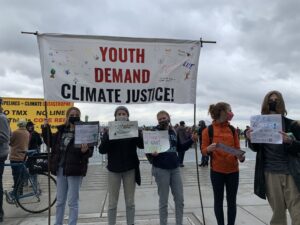
Yesterday’s march entirely organized by youth and featuring speakers who were almost all BIPOC, was beautifully organized by them as well as carried out.
We started at Pier 62 on the waterfront. here is the beginning with 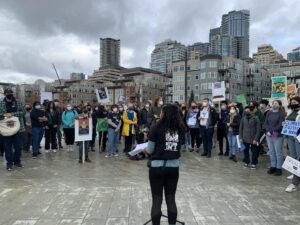
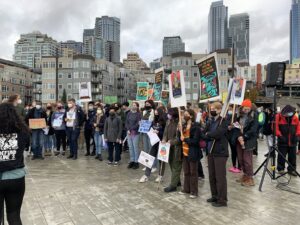
both a land acknowledgement and a song/prayer by a native youth.
The signs were really good.
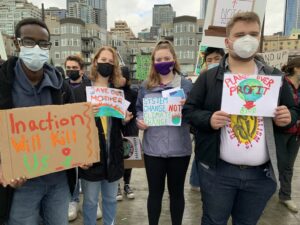
Inaction will kill us

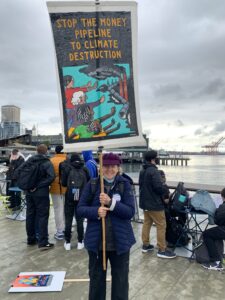
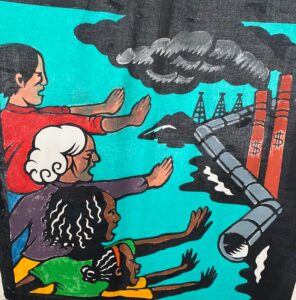
Here I am with one of the terrific signs.
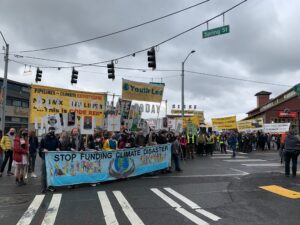
There was some important information handed out about the fraud of carbon cap and trade, and the huge pollution from the military.
We marched up first avenue up Union to Chase Bank, one of the funders of the pipelines. We had speeches, songs, and a die in. The Seattle Times managed to put a photo on the front page without including Chase Bank in the background, it showed mainly knees!
Here is where we lay down ( not me). Then I took a video, hopefully coming soon 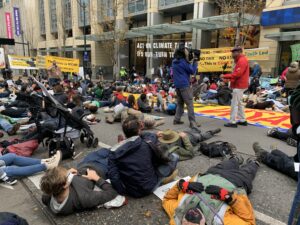
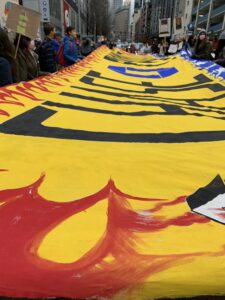
There was more beautiful singing, and then we made a memorial in front of Chase Bank to all we are losing . I contributed a small ceramic grasshopper. Maybe you can see it in the midst of the candles. I was just reading about how many insects are disappearing.
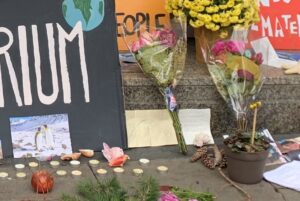
Here is the memorial with some details. It was really moving. ( There were a few cops with bikes standing by and I heard one of them say, we are preventing the windows from being smashed, and we will stay until maintenance cleans this up. I guess they don’t have any children)
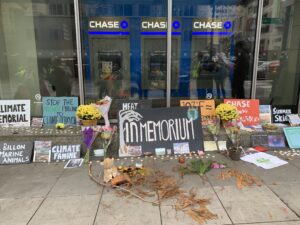
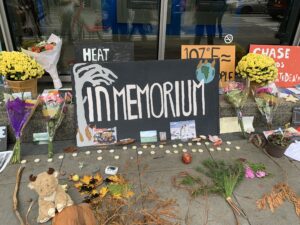
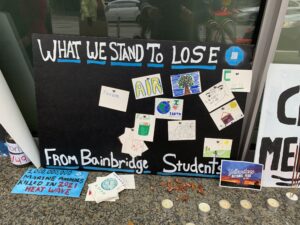
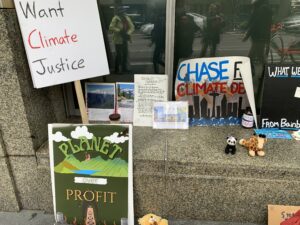
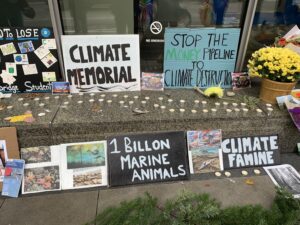
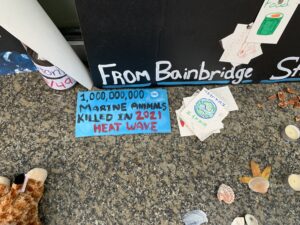
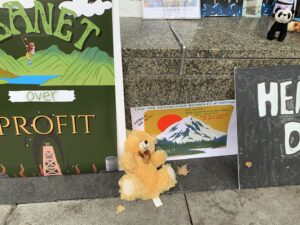
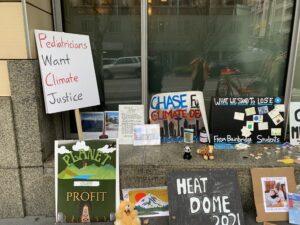
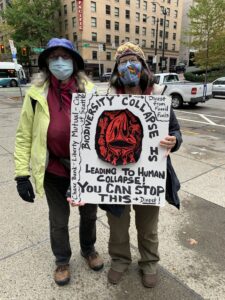
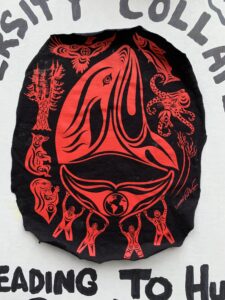
Impressive sign with Paul Cheroketen Wagner’s image
in the middle
then we went on to Liberty Mutual Insurance Company. they are insuring the pipelines that are going through native lands all over the place, including most famously in Northern Minnesota with the horrific line 3. the second image is some street theater with Emus sticking their heads in buckets of tar sands, then convincing the employees of Liberty Mutual that they have agency to do something, and finally freeing the emus.
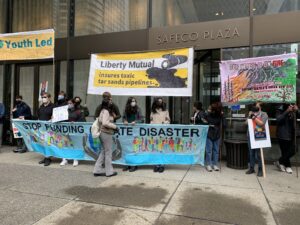
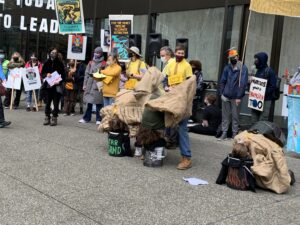
Below is a young Tlinglit woman was really articulate about resisting pipelines. I am hoping to make You Tubes of my video recordings and add them to the post, as the songs and speeches were really eloquent.
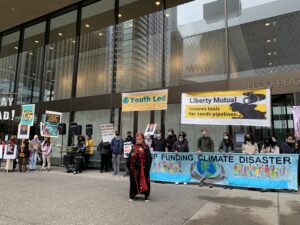
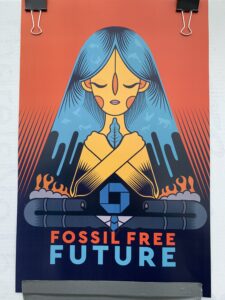
This entry was posted on October 30, 2021 and is filed under Uncategorized.
Firelei Báez, To breathe full and free
Pamela Allara, Ph.D., my colleague in art history and all things, contributed this post about a stunning exhibition in Boston.
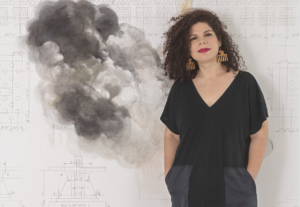
Firelei Báez’s installation, “To Breathe Full and Free: a declaration, a re-visioning, a correction…” at the Institute of Contemporary Art’s Watershed gallery was one of the most exciting exhibitions that the ICA has mounted in the three years since it opened at this location.
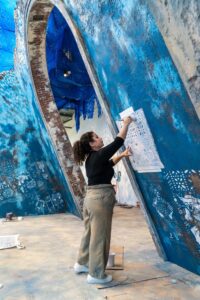
The artist at work on her monumental installation
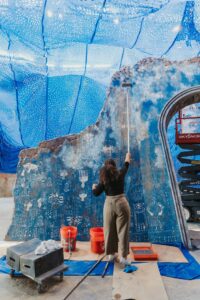
It is certainly the most memorable.
Firelei Báez was born in the Dominican Republic in 1981. Baez’s mother is Dominican and her father Haitian. Because the Dominican Republic was settled by the Spanish, and Haiti by the French, there has always been tension between the two countries. It is this unsettled history that Baez brings to the surface in her installation.
In the main exhibit space, a monumental series of arches rise up from the marina where the Watershed is located.
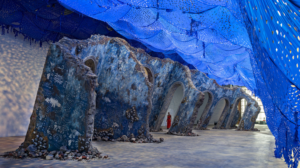
Firelei Báez, To breathe full and free: a declaration, a re-visioning, a correction (19°36’16.9″N 72°13’07.0″W, 42° 21’48.762″ N 71°1’59.628″ W), 2021.
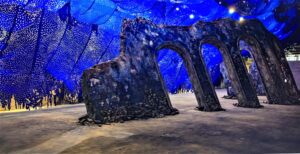
Firelei Báez, To breathe full and free: a declaration, a re-visioning, a correction (19°36’16.9″N 72°13’07.0″W, 42° 21’48.762″ N 71°1’59.628″ W), 2021.
From the color photograph at the exhibit’s entrance we learn that the installation references the ruins of the Sans-Souci palace in Haiti. Sans-Souci was built by Henri Christophe, a former slave. He became a revolutionary general who crowned himself king. He is part of the heroic history of Haiti as the site of the first successful revolt by slaves against a colonial power in this case France.
The palace itself was destroyed by an earthquake in 1843, its ruins a potent symbol of the region’s turbulent history.
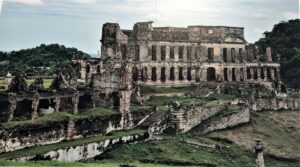
Sans-Souci Palace, 1813. Haiti
The artist created a smaller version of Sans Souci on the Highline in 2019
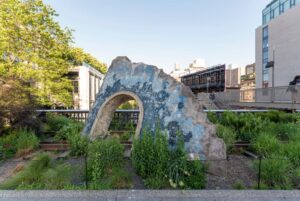
Báez further layers that history with Boston’s own. As one approaches the Watershed space along Marginal Street in East Boston, one passes the decaying former docks on the harbor where for two centuries Boston entrepreneurs actively traded goods, including until the early 19th century, human goods.
As generally told, Boston’s history is a triumphant one, emphasizing the shedding off of oppressive British rule, but Baez reminds us that history is often more complex, and more morally conflicted.
Ironically, Báez was told when she was growing up that as a Dominican, she had no history. The installation makes clear that we all carry histories with us, and it is important to acknowledge and reflect upon them.
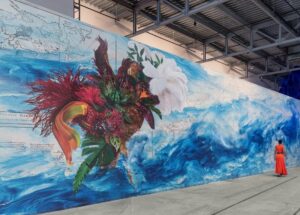
On the entry wall, has painted a large, impressive mural. On the upper left is an inset reproducing a 19th century map of “Boston Harbor and ‘The Sea of New England.’” – the artists fascination with maps has appeared in other works as here
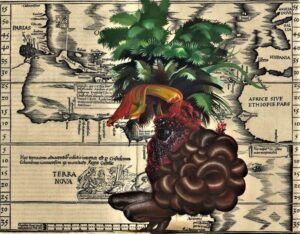
The waters of the harbor, occupying the majority of the mural’s space, are appropriately turbulent, and on inspection one finds that immersed in the waters is a map of Boston and Cape Cod. It also includes the barnacles so common in the nearby waters.
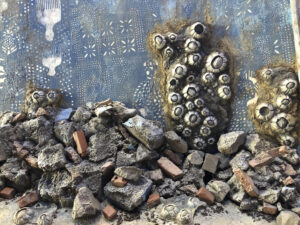
Below the map, Báez has painted a large bouquet of marine flora, ferns and feathers, all native to the Caribbean.
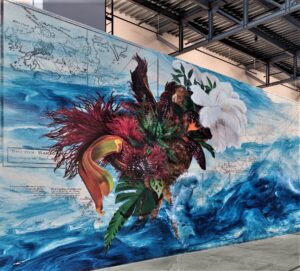
She has stated that the bouquet also contains a mythological figure from Dominican folklore, Ciguapa; perhaps those are his wings we see at the top of the image. Where one would normally find texts and images provided by the curator, here we have a seascape whose history we must attempt to navigate before entering the main space.
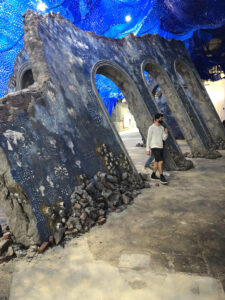
Once, there, we leave Boston and its maritime history behind, and are plunged into a different space altogether. As if rising from the ocean floor itself, a monumental ruin punctuated with arched openings she constructed in the space from foam, plywood and plaster tilts across the space. A pierced blue fabric draped from the ceiling provides the illusion that we are perhaps underwater. The sense is both unsettling and exhilarating. One is drawn to walk through and around the arches in order to get a feeling for the palace it references.
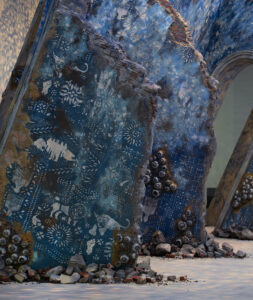
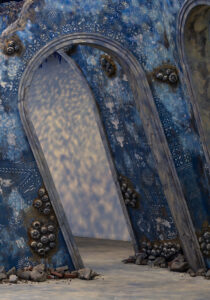
But as with all ruins, much is left to the imagination. We must reconstruct this history on our own. The blue references the ocean, to be sure, but also, according to the artist, the valuable indigo dye used by the Yoruba in Nigeria for their cloth, which brought them wealth through its trade.
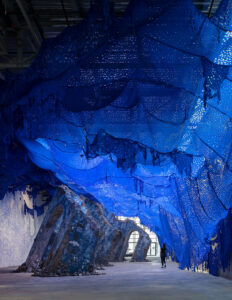
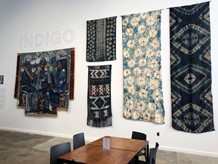
The history of this trade is explored in the accompanying installation by Boston artist Stephen Hamilton. The images Baez has screened onto the structure initially hold some clues, but why a lion and a panther, neither native to the Caribbean, obviously, and what do the abstract symbols refer to?
This civilization remains obscure and remote, and what’s left of its history, as indicated by the barnacles that ring the bottom of each arch, is decaying. But before the arches sink back into the (ocean) floor, we are drawn to repeatedly walk in and around them as if they might reveal the cause of the structure’s demise. Of course, as we walk, it is impossible not to ponder the decline of all past civilizations and the inescapable fact that our own seems to be on the same trajectory.
Even though this is a created ruin, I found it as compelling as visiting actual ruins. Why do we go to Knossos or to Chichen Itza? For me, and I suspect for most visitors, they bear witness to human creativity, which endures even as civilizations decline. Thus, the monumental architecture is a metaphor for human achievement in general. And finally, the works, even in their ruined state, are beautiful, and in their beauty, remain inspiring.
Photo Credits
Artist Portrait Antoine Boontz
Artist at work, and Untitled Terra Nova: Amani Willett for The New York Times
Installation view, ICA Watershed, 2021. Courtesy of the artist and James Cohan, New York. Photo by Chuck Choi. © Firelei Báez
Close Up of Sans Souci arches Jesse Costa/WBUR
Mural details and Sans Souci on the Highline Courtesy of the artist and James Cohan, New York. Photo by Chuck Choi. © Firelei Báez
Barnacles Pam Allara
This entry was posted on September 18, 2021 and is filed under Art and Ecology, Art and Politics Now, ecology, Uncategorized.
Imna Arroyo: Immersed in Yemaya and Iroko Water and Life
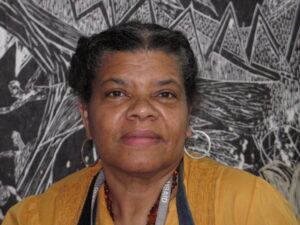
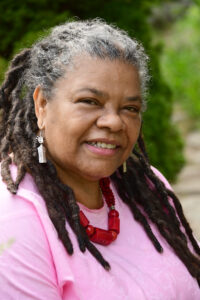
Imna Arroyo’s work, taken as a whole, creates a puzzle of intersecting chronologies, which appear to form the subjective representation of an aesthetic philosophy that reaches toward celestial planes. Humberto Figueroa Iroko, Tree of Life, p. 56
Imna Arroyo bridges art and spirituality in a deeply personal and effective art. She embraces several large themes in her work, that she rethinks and alters each time she creates an installation. Thse two portraits capture two sides of Imna Arroyo, her connection to art and her connection to nature.
Of African, Taino and Spanish heritage, Imna Arroyo is an Afro-Puerto Rican artist deeply committed to acknowledging her multiple heritages and to transforming that heritage into a contemporary artistic statement. Throughout her career she has consistently reached beyond her current work to the next level of creativity, complexity and technical proficiency. She has never settled for a formulaic answer, a single concept, or even a single media. As a result she tells a layered story of her life that resonates with history, place and spirituality. She frequently turns to the symbolism and language of Yoruba poetry, proverbs, legends, myths and imagery.
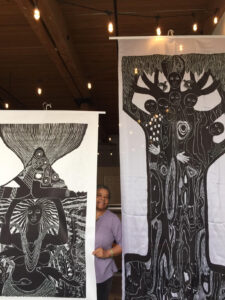
As an artist printmaker Arroyo has had an exceptionally rich training, as she constantly explores new techniques.
As a young woman in the 1960s she studied with José Alicea in Puerto Rico. After coming to the United States , she earned a BFA from Pratt Institute in 1977 studying with Michael Ponce de Leon and Robert Blackburn. Only two years later she completed an MFA at Yale University. With Gabor Peterdi and Winifred Lutz and later Krishna Reddy she further explored etching, aquatint, and color intaglio techniques. In the ’80s Arroyo moved onto mixed media, multi-color Japanese traditional woodcut techniques with Francisco Patlán in Mexico, and aluminum plate printing at Tamarind Institute.
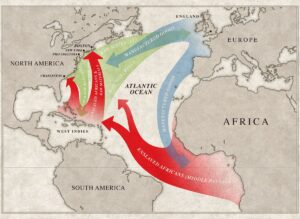
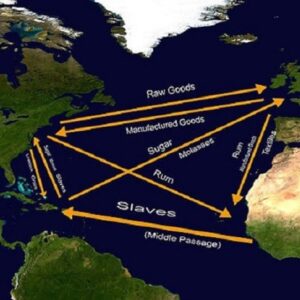
Part I
The Middle Passage
Starting in the late 1500s more than 12 million Africans were transported as slaves from Africa to the Caribbean, then sold for sugar and other raw materials to take back to Europe. The horror of this crime is so great that we are all still processing what it means.
Many artists of African descent address this topic from different perspectives.
Imna Arroyo’s major installation Ancestors of the Passage focuses on those who did not make it through the three week voyage in unspeakable conditions
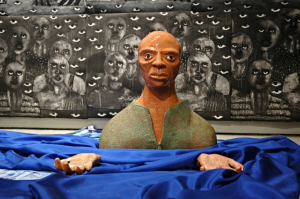
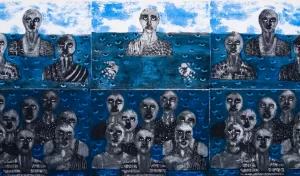
Those who were sick or died were simply thrown overboard. Ancestors emphasizes the spirits of those who died, making them visible in prints and sculptures. She speaks to the presence in the lives of those who survived in memories and cultural practices that came to this country.
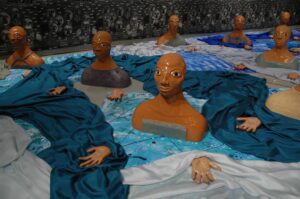
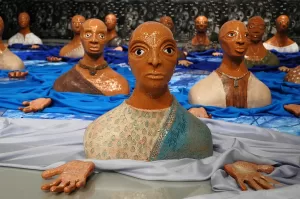
Ancestors of the Passage overwhelms and embraces us with its striking blue sea on the floor, the ceramic busts and hands of those lost in the sea, and a series of prints that cover the walls with haunted faces.
As the artist describes it
Ancestors of the Passage: A Healing Journey Through the Middle Passage is composed of twenty-seven life size terracotta ceramic figures each extending their (54) hands reaching out to the audience. The figures are in a sea of acrylic canvases and blue and green silk fabric, surrounded by (60) black and white collagraphs representing a multitude of people witnessing the journey. The terracotta figures depict the African ancestors that died and are coming back to tell us to remember our gifts. This artwork attempts to gives a visual voice to the untold story of the millions of people who died during the Atlantic crossing.
Arroyo’s awakening and exploration to this horrendous act came when she visited the Door of No Return in Ghana:
In 1997 I traveled for the first time to Ghana. It was at the Elmina Castle, standing in front of the Door of No Return that I had an epiphany that we are all part of a spirit continuum. It was an experience that made me aware of the ancestral realm and forever changed my perception of time and space.
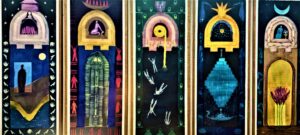
In 1999 she created a series of watercolor paintings called Prelude to the Door of No Return with doorways evoking the shape of the original Door of No Return in Ghana. The artist filled the space of each door and the space around it with references to the Middle Passage, bodies, hands, slaves packed into ships. We can see the roots of the larger Ancestors installation in these abbreviated references.
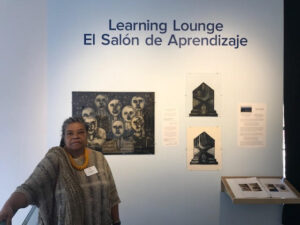
The Prelude to the Door of No Return was reinstalled in “After Spirituality” at the Fitchburg Art Museum from February to September 2020, at the height of the pandemic. It was paired with an altar with a segment of the Ancestors installation to honor those who died in the Middle Passage as well as in the pandemic.
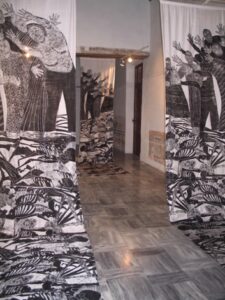
Trail of Bones
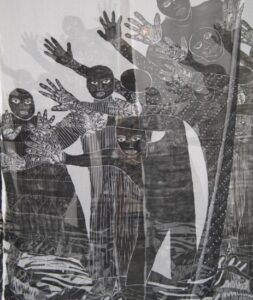
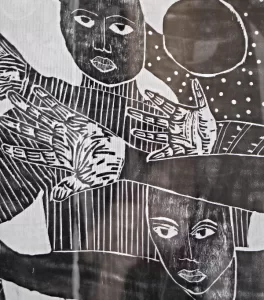
Arroyo has another moving installation referring to death in the Middle Passage, Trail of Bones, an immersive experience in which floor to ceiling black and white prints hover over us. We experience the spirits of those who died and those who survived. A moving video of Trail of Bones appears on her website.
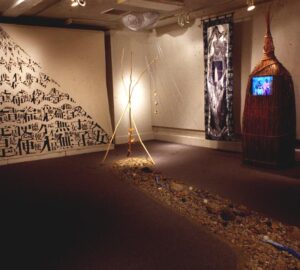
Voices of Water Installation with streambed by Arroyo
Arroyo began exploring Yemaya, Goddess of Water, as a theme in her work in the summer of 2001. It is a logical step from exploring those who drowned in the sea during the Middle Passage to invoking a spiritual presence that both looked over them and looked out for the survivors.
The video The Many Faces of Yemaya first appeared in 2001 in an exhibition “The Voices of Water” in Oregon and the Czech Republic, a collaboration among several artists including Native artist Gail Tremblay.
The video was the partner to an eight-foot-high expressionist woodcut of the sea goddess, the archetypal great mother, printed on satin (visible on the right in the image). The video and the woodcut invoke the seven avatars of this divinity. Yemaya is a deity of orisha worship that originated in Nigeria and later came to the Caribbean and the Americas.
“Voices of Water” was a crucial turning point for the artist in both multimedia and interdisciplinary collaborations, which is still a central part of her work. Her interest in Yemaya has expanded in many directions.
Initially the artist explored the meaning of Yemaya in books such as Yemaya y Oshun , Kariocha, Iyalorichas y Olorichas by Cuban anthropologist Lydia Cabrera. Then she herself engaged with the spiritual practice. In the summer of 2005 Imna Arroyo was initiated into the Lukumi tradition in Cuba.
She received the honorary title of Chief Imna Arroyo/Chief Yeye Agboola of Ido Osun, (Chief Mother of the Garden of Honor) conferred by his Royal Majesty Aderemi Adeen Adeniyi-Adedapo, Ido-Osun, Nigeria, West Africa the morning of his 50th birthday in 2007.
The House of Yemaya woodcuts are printed on fabric framed with Batik cloth. Yemaya is depicted as a mermaid on the inside and the Virgin of Mercy on the outside referencing secret relationship between the African and Catholic religion practices in Cuba.
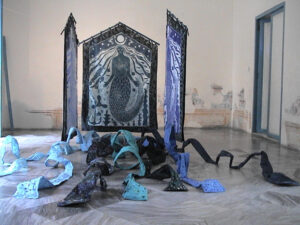
House of Yemaya installation
The Many Paths of Yemaya is a multi-media installation composed of seven panels 2’x 8’ woodblock prints and floor installation recreating the Atlantic and the Caribbean oceans made of fabric batiked by the artist accompanied by handmade paper sculptures, shells, glass, wood sculptures. The panels are printed on Satin and framed with Batik fabric from Ghana, West Africa. A six-minute video is also part of the artwork.
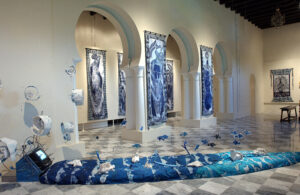
The Many Paths of Yemaya 2000-01
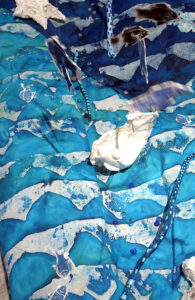
Yemaya floats in midair in the installation Legacy: Ancestral Thread Series:
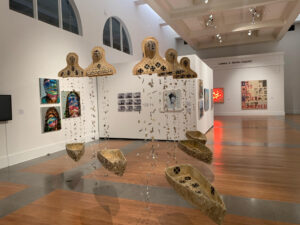
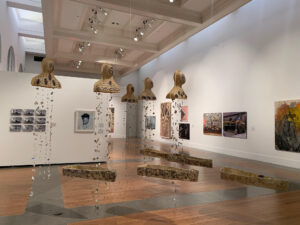
Arroyo describes it:
The installation is composed of five African Orishas or Deities that served as guardians to the ancestors while they were crossing the Middle Passage: Trans Atlantic slave trade. Those who survived the journey brought their multitude of memories from the homeland. My work attempts to re-capture these memory fragments of the Diaspora, weaving together the legacy.
We see the five Orisha busts, three males Elegua, Obatala & Shango and two females, Oshun and Yemaya, made of wire mesh, abaca fiber, hand-made cast cotton pulp suspended in mid air, as memories suggested by small pieces of cotton pulp flow from them down to the floor. Underneath are boats of the same materials.
This work suggests survival, even rejuvenation, through memory and spiritual searching. In some installations the sculptures pair with prints depicting The Journey, small boats with figures, protected or sometime carried by an image of a goddess.
The artist reinstalled Legacies in 2020 in the Coral Gables Museum in the exhibition “Alien2020nation” from December 2020 to March 2021
The catastrophe of the slave trade, the Middle Passage and the protection of the Orishas for those who survived and brought memories of their culture with them, brings us directly to the ongoing tragedies of our contemporary world.
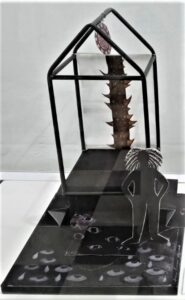
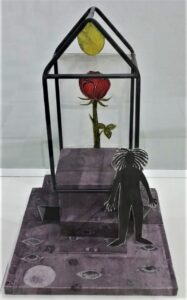
A recently completed diptych, Thorns and Roses a message from the ancestors speaks of our last two years. Two small house-like structures stand on collagraph prints filled with the eyes, perhaps of those drowned in the Middle Passage, or those of more recent tragedies) In one house a thorny stem invokes the pain of life, in the other a rose represents the gifts or blessings discovered throughout these past seven months of COVID-isolation. It appeared in the exhibition A isla miento (Isolation), November 2020 shown in San Juan Puerto Rico, an invitation to artists to address the pandemic. Outside each house stands a cut out women, the artist.
As she explained:
we can choose in our isolation to be safe inside or to feel freedom, to be sad or to be angry.
In the midst of the quarantine, we witnessed the public lynching of Mr. George Floyd, even as more young black bodies were killed by police violence. We continue to see displays of white supremacy, people without the sheets or burning crosses gathering in the streets.
Experiences that seem way too common for the African ancestors who endured violence perpetrated against their black bodies for generations stretching over 400 years. Here, experiences emanating from hate, supremacy, exploitation, greed and inhumanity are the thorns. While the strength and genius of the people are inherent gifts bestowed by the ancestors to navigate uncertainty and overcome adversity, here is the rose.
PART II IROKO TREE OF LIFE
At the same time as these works pairing the Middle Passage with the Orishas, Imna created a series based on “Iroko, Tree of Life.” It culminated in a multimedia collaborative exhibition in 2017, and it is still going through new iterations. The 2017 exhibition included prints of the Ceiba, Tree of Life that depicted its transformation in various cultures.
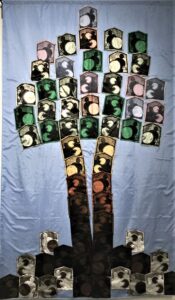
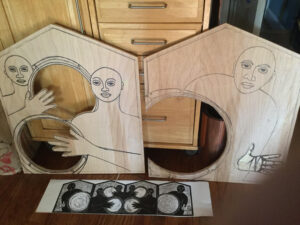
Humberto Figueroa, the curator, describes the installation
“The Iroko installation draws us into a dense thicket of vines that
multiply through the effects of their shadows. Among the twisted
branches, we can make out the silhouettes of simple pitched-roof
houses, typical of the working-class and poorer households of
the Caribbean. The houses in this installation represent the axes
for the divine forces from the Yoruba religion. The deities called
Orishas are represented in the Iroko, and these framed spaces
are meant to signify presences that are intangible and invisible
to the naked eye. The installation extends upward with the
incorporation of numerous other houses in which we see open
palms suggesting supplications to the celestial plane or invocations
to ancestors whose remains reside beyond the horizon. The tree
trunk is suggested by a clustering of houses peopled by inquisitive
eyes and other hands containing faces.
At the foot of the tree, representations of the Orishas can be seen on the floor. The general harmony achieved between the balance of materials and the techniques of engraving and sculpture in an evocative spatial arrangement instills a sense of serenity that is also conducive to multiple interpretations. The Iroko installation is a comprehensive visual text inspired by spiritual expressions filtered through time, other cultures and contexts.”
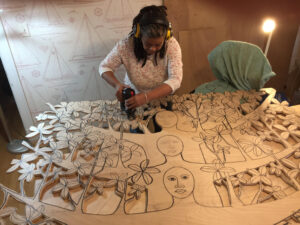
working on the plywood plate of Yoruba Gaze
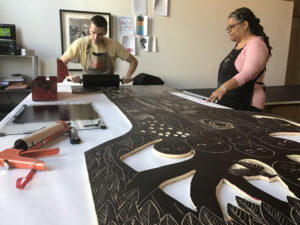
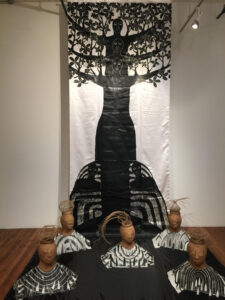
Yoruba Gaze Installation
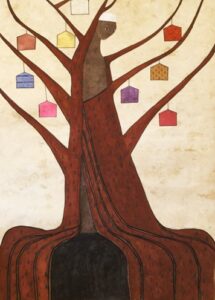
Iroko in the House of the Orishas
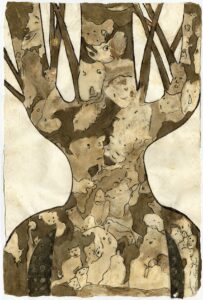
Baobab Tree of Life of Africa
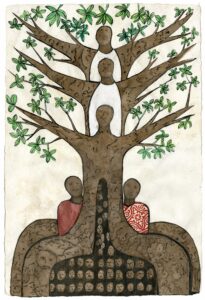
Odudua Obbatala Chango Agayu Sola
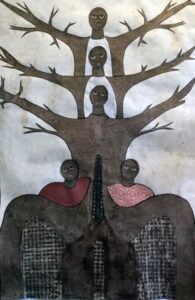
Yoruba Sacred Tree in the Antilles
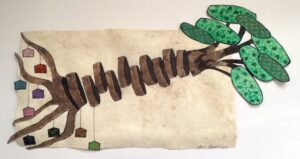
Transcendental Ceiba
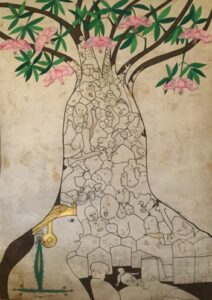
Yaxche Sacred Tree of Maya
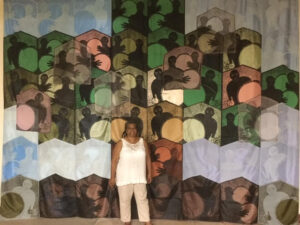
The artist in front of the giant print IROKO Tree of Life, Amate paper, clay sculptures, relief print tapestries and handmade paper with encaustic, reed fiber woven sculptures with the multi-media video.
The artist describes IROKO: TREE OF LIFE:
IROKO was inspired by the sacred Tree of Life, known as Iroko to the Yoruba people of West Africa and those of the African Diaspora, Yaxché to the Maya, Kapok in Southeast Asia, Silk- Cotton Tree to Indigenous North Americans, and La Ceiba in the Caribbean, Central and South America. The tree is of great symbolic, spiritual, mythological, medicinal, magical, commercial, ecological and aesthetic import. Through the exploration of materials old and new, traditional and innovative technologies this multi-media installation focuses on the mysteries of nature using the Iroko/ Yaxché/ Kapok/ La Ceiba / Silk-Cotton Tree as an anchor to express the power of nature, its continuity and resiliency which hold the promise for a sustainable future if nurtured and honored.
Arroyo worked in collaboration with graphic and digital media artist, Tao Chen, and video producer, Jaime Gomez. on a video accompanying the huge print
In the video, filmed by Julio Charris, Jaime Gomez interviews the Katanzama Indigenous people of Columbia. It also includes a dance choreographed by Alycia and performed by Sinque Tavares. The music includes traditional Yoruba Orisha songs sung by Amma McKen, Iya Ola and Swahili Henry and a new dance performed Bright-Holland.
Bringing together many voices in the video, as well as the large print, profoundly speaks to our interconnections. As the artist eloquently explains:
IROKO addresses the challenge of climate change by exploring the interrelationship between our external ecological situation, our awareness of the sacred in creation, and our internal relationship with the symbolic world of the soul. IROKO’s intention is to promote art that expresses that complex, diverse and dynamic intersection, while seeking to connect the intellectual, spiritual and practical components of community building and sustainability.*
A part of the “Iroko Tree of Life” joined an exhibition at the ChShaMa exhibition space called AfreeCan in April and May 2021 in New York City.
Prayer for a Warrior Island
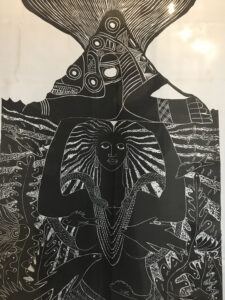
Currently, September 2021, at the Museum of the Americas in Puerto Rico Arroyo contributed Plegaria para una isla guerrera Prayer for a Warrior Island organized by Las Jornadas del Grabado Puertorriqueño. It was carried in a protest in Puerto Rico.
This print pays tribute to the ancestors of the valiant Taino Indigenous people and the African warriors whose legacy continues to empower their dependents to defend the island from the colonial pirates, imperialists conquistadors, opportunities, embassies, rogues and liars.
We can all immerse ourselves in Imna Arroyo’s extraordinary art works that fuse spirituality, art and nature, with specific resferences based on her own varied experiences. Her carefully thought out prints and multimedia installations can provide us with new hope and perspectives in our present state of climate catastrophe.
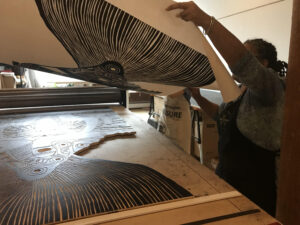

Part 3 The Future!
Imna Arroyo: Travesías / Crossings is the title of Imna Arroyo’s current project. It will be a major retrospective, focusing on her interpretation through her art of displacement and migratory flows. Co-curated by Humberto Figueroa from Puerto Rico and Benjamin Ortiz of Connecticut with Yolanda Wood, a cultural critic based in Cuba and visiting professor at the Universidad Nacional Autónoma de México. Project , it will be seen at 3 venues: Museo de las Americas, La Casa del Libro in San Juan, in Puerto Rico and Caribbean Cultural Center African Diaspora Institute in Harlem, New York.
———————————–
All quotes from Imna Arroyo based on our email correspondence, August, September 2021.
*IROKO TREE OF LIFE, Ancestral imprint, the Yoruba Cultural Association from Cuba, 2017. It features essays by ecologist, Carmen R. Cid, art historian, Maline Werness-Rude, and writers Isis Mattei, Maria Vazquez, Esperanza Cáseres Santa Cruz, Jaime Gómez, Migdalia Salas and Humberto Figueroa. The exhibition opened in 2017 at the Connecticut the Clear Gallery, Charter Oak Cultural Center in Hartford and MS 17 Art Gallery in New London.
This entry was posted on September 8, 2021 and is filed under Art and Activism, ecology, Feminism, Uncategorized.
Defusing Radical Alice Neel

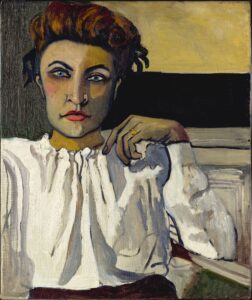
Observe these two portraits
On the right is the feature image of the Metropolitan Museum of Art current exhibition of the work of Alice Neel “People Come First”
It is identified as a portrait of “Elenka”1936, about which there is no information except that she “presumably numbered among the several bohemians with whom Neel associated in Greenwich Village” Neel lived in Greenwich Village from 1931-38 . It was donated to the museum by the sons of the artist.
On the left is “Marxist Girl (Irene Peslikis) 1972 – radical feminist and crucial supporter of second generation feminism. Her pose and clothes suggest her radical position, austere colors, monochrome black, unadorned, with a confident leg slung over one arm of the chair, and a single arm raised that shows her unshaven armpit. In addition, Peslikis is famous as a founder of Redstocking Artists in 1971, she co founded the Feminist Art Journal, which also in its first issue supported Neel . The Met catalog finds it curious that the work was titled “Marxist Girl” when, as they claim she was “known at the time not as a Marxist but as a feminist.” But they also mention that she was an early member of New York’s Radical Women, a group that is avowedly Marxist and more specifically and defiantly Trotskyite. The Met catalog says RW is “feminist”. Clearly the Met wants to rush away from any Marxism in the 1970s, just as they want to avoid Communism and Socialism in the 1930s
Elenka on the other hand, wears a ruffled, white blouse, her hand dangles languidly in front of her shoulder without intention. She wears careful makeup. Her face is expressionless and mask like.
The differences are telling: in clothing, in pose, even in the yellow background, which in Elenka is pale and in Marxist Girl is intensely saturated. One woman appears to be static, the other dynamic, so although we know little about Elenka, we can tell she was not an activist from the portrait.
So why did the Met decide to put this portrait on the cover of its catalog? Perhaps because they owned it as a gift from the artists sons, but more important, because it is a mild image compared to Irene Peslikis, it deflates and defuses the radicalism of Alice Neel.
And admirable as this large exhibition is with its many categories, large, intelligent catalog, and memorable array of paintings and documents, that seems to be the overall purpose of the exhibition, to soften Neel’s extremely radical painting, perspectives and position.
Let us look at this quote near the beginning of one essay. It describes Neel as having “a stalwart sense of purpose in her dedication to an ethic of radical humanism”.
Radical humanism? Humanism is the word that these authors have latched onto, (mis)quoting Neel frequently from late interviews.
For example this is an example cited from a comment of 1950 to demonstrate her “humanism” “I have tried to assert the dignity and eternal importance of the human being.”
That of course is not the same thing as humanism!
Then they turn around her radical commitment ” Encounters with socialist and Communist activists in the United States in the late 1920s and 1930s further shaped Neel’s humanism. She joined the Communist Party in 1935 and was intermittently affiliated with the group for the rest of her life.”
To call Communism a shaping of humanism, is indeed an effort to dilute the artists deep commitment to socialism, to presenting what had been unpresented in art, the poor, the worker, the leftist leaders, and so much more.
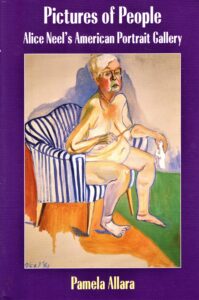
Let us contrast this effort to smooth over Neel’s politics to the ground breaking book on Alice Neel by Pamela Allara, Pictures of People, Alice Neel’s American Portrait Gallery 1998. Allara says Neel “rebelled through both an unconventional life-style and a biting wit, actions and words that indicated an absence of self censorship, a determination to disrupt polite society.”
Allara then brilliantly maps the many types of disruptions that Neel pursued.
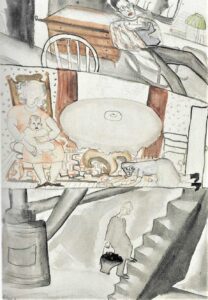
To give one example, In The Family 1927, Neel gives us the antithesis of a happy family portrait. The father slumps over in the basement as he carries coal, the mother lies almost prone on the floor as she wildly scrubs, the mother and baby ( Alice and her daughter) sit oversized in a chair, while the brother in the attic is the oblivious intellectual. Each floor suggests complete isolation. Allara compares it to the sharp descriptions in Sherwood Anderson’s small town stories, while the catalog speaks to the conflicts of motherhood and creativity which of course is not shown here.
Neel’s biggest disruptions in both her art and her life though are still to come as she lived as a single mother in poverty in the Bronx from 1938 – 1962, and in Spanish Harlem after 1962. She was on the Left from the start and stayed there.
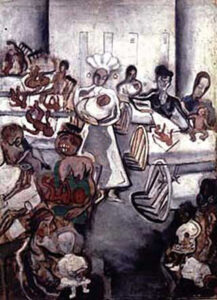
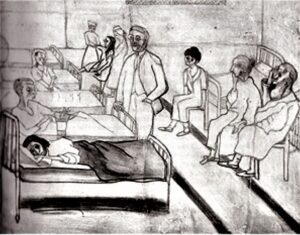
Her depictions of such subjects as “Well Baby Clinic” (left) “Suicide Ward,” (right) give us sardonic information about the failings of the public health system and social services, a subject of great importance today.
Allara’s book is mostly chronological, which makes sense with Neel as her life and her work were deeply affected by dramatic changes in the social and political climate of the 1930s, 1940s, 1950s, 1960s and 1970s.
The Met exhibition had themes ( they don’t appear in the catalog, to which I will return shortly)
Here they are
Introduction
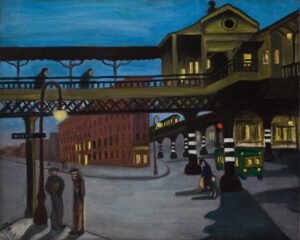
New York City (street scenes, including demonstrations)
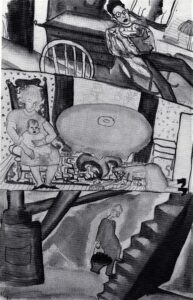
Home ( emphasizes her studio as her home, with intimate erotic images) Family is placed here, pretty much the antithesis of “home”
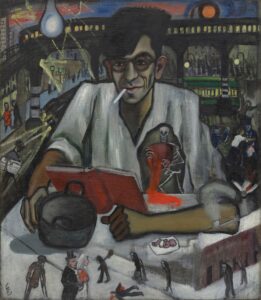
Counter/Culture ( portraits of as the label puts it “individuals who pushed social, political, and cultural boundaries, from bohemian poets and labor organizers to queer performance artists and feminist trailblazers.” So we have the radical leftist Kenneth Fearing above and the cross dressing Jackie Curtis and Rita Redd)
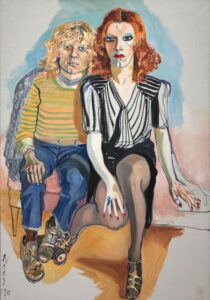
In other words all in one section we have every decade and many different types of people.

The Human Comedy “documenting episodes of suffering and loss, but also strength and endurance, with unsparing candor and acute empathy” The term is based on Balzac’s Human Comedy of the 19thcentury. Here is the Well Baby Clinic mentioned above.
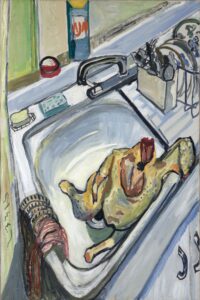
Thanksgiving 1965 was part of Art as History. This section aligned Neel’s work with such luminaries as Robert Henri, Jacob Lawrence, and Chaim Soutine, as well Cassatt, and Van Gogh. Of course this is the most sardonic Thanksgiving image I ever saw.
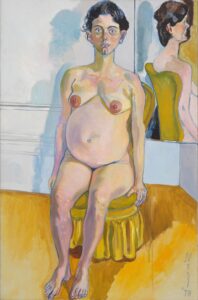
Motherhood includes images of both pregnant women, the famous image of giving birth and mother and child portraits, the term motherhood seems to me a little cozy for Neel’s cutting and incisive portraits
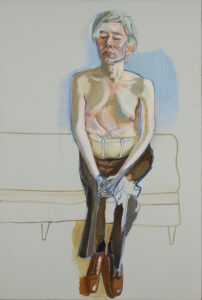
The Nude male and female; these two sections overlap of course and both include pregnant females. Neel’s painting included here of Andy Warhol after he was shot deserves a whole section and essay on its own!!!
Good Abstract Qualities I don’t need to elaborate on why this was here at the end. Sigh, Greenberg rears up.
In other words, these themes obscured social realism in many different places, it spread the pregnant women into three or four places. it grouped different topics together, etc.
The catalog does a better job, with excellent essays by several insightful writers (aside from the smoothing, soothing affect mentioned above). Here are the chapter headings
Anarchic Humanist, Political Creatures, Siempre en la Calle, Ill Show Everyone: An Artist Mother at Home, Painting Fruit(s), Alice Neel’s ‘Good Abstract Qualities’ based on a quote from Neel the year before she died, “I don’t think there is any great painting that doesn’t have good abstract qualities” here elevated to a major theme.
So was this major analysis by some of the best art historians now working at our most prestigious museum trying to sooth us, the audience, the museum board, the Neel family, or were these the positions of the curators and authors. It is hard to know.
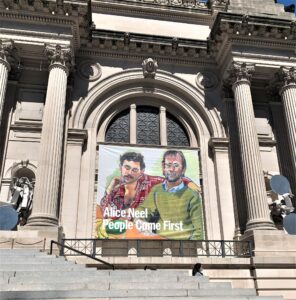
At any rate, the main image on the front of the museum gives us a powerful portrait of gay men. As Randall Griffey points out, Neel died right before AIDS devastated the gay community . Several of the people she portrayed died. Griffey points out that she would not have hesitated to paint the ravages of AIDS. So this banner celebrates a moment in our country’s history, before the epidemic, as well as Neel’s own independence in representing gay men and woman throughout her career, in spite of the homophobia of the Stalinists and the Leftists surrounding her.
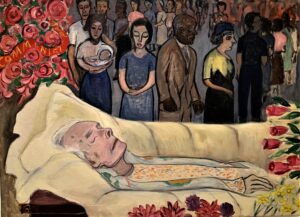
But unquestionably her radicalism continued throughout her life, (above is The Death of Mother Bloor, 1951 at the height of the McCarthy era, a funeral that she attended) , her feminism was deep seated way before the 1970s, and she continued to radically transform the little regarded format of a portrait until the end of her life. No better example exists than her own nude self portrait at the end of her life
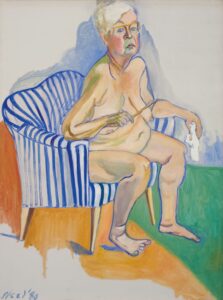
This entry was posted on August 24, 2021 and is filed under Art and Activism, Art and Politics Now, art criticism, Contemporary Art, Feminism, Uncategorized.
One art exhibition
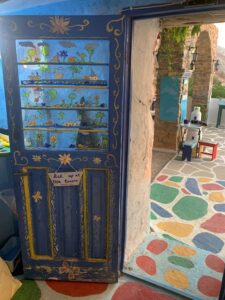
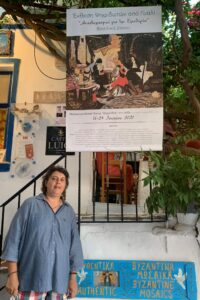
We only went to one art exhibition on Amorgos. The work of Zaxou Vasiliki. You see her here with the poster for her exhibition and the entrance to her small shop . Her exhibition was in the Chora. Her shop is in Langada.
Xazou creates portraits from stained glass that she cuts into mosaic like pieces. This is a series of heroes from the war of
Independence.
The first one is Laskarina “Bouboulina” Pinotsi , a female captain. She lived from 1771 – 1825
. 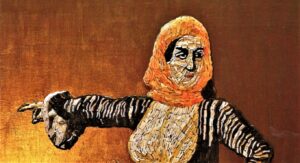
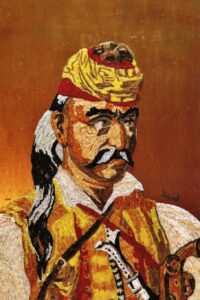
Theodoros Kolokotronos 1770 – 1863
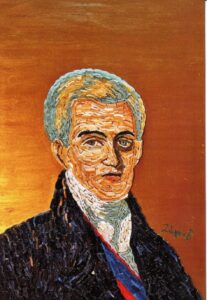
Jionnis Kapodistrias 1776 – 1831
Odysseas Androutsos 1788-1825
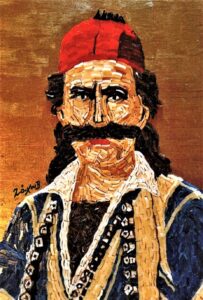
Georgios Karaiskakis 1782 -1827
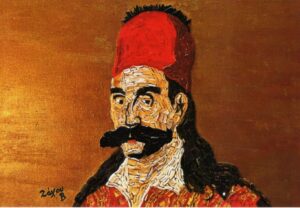
Athanasios Diakos 1788 – 1821
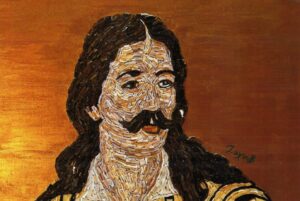
Andreas Miaoulis
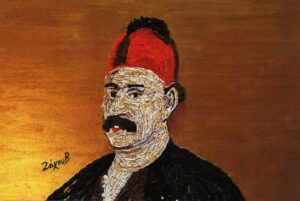
Mantoo Marrogenous 1796-1848
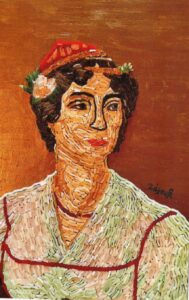
There were many more, but I didn’t manage to get translations of their names.
Finally this is a secret Greek school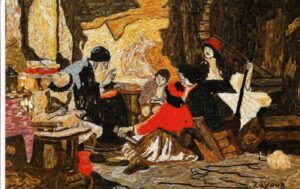
This entry was posted on August 11, 2021 and is filed under Uncategorized.
Creative Lving in the Cyclades
Of course everyone I spoke of in the last post was creative, archeologists at the museums and the Temple of Demeter, textile artists, potters, Kitron distillers.
In this blog post I am highlighting another creative person,
Sofia Gavala, partner in the stunning Amorgos beach hotel Lakki Village Family Beach Hotel
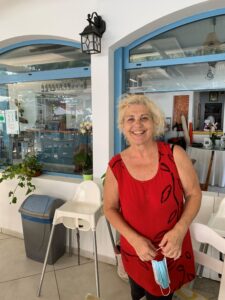
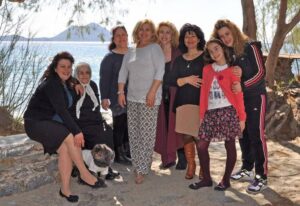
This hotel is run by the Gavala family. There are five sisters. Here they are when their beloved mother was still alive. Third from the left, near Calliope, the mother, is Niki, who is the business brains behind the Lakki hotel. It started as a vegetable garden then began serving a few drinks on the waterfront, in the early 1970s, next a room or two, next a restaurant, and now it has 65 rooms, a swimming pool, and a delicious restaurant!!!!
Here is the entrance to the hotel, notice the ecological sun shade
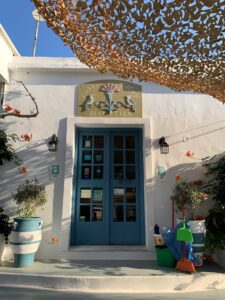
We had the great good fortune to stay here for two weeks on our visit to Amorgos to have a memorial to Henry’s sister Carolina.
The hotel faces the beach and the sea, shaded by ancient tamarisk trees, so part of its special feeling is its unique location, hopefully not endangered by climate change. The Aegean sea here is not at all tidal, and they have a high wall between them and the sea, but still the sea did come right up to it at times.
Before I share Sofia’s artistic constructions throughout the hotel, here is the “dining room” and the beach right in front. Picture me on one of those chairs reading and swimming every day! 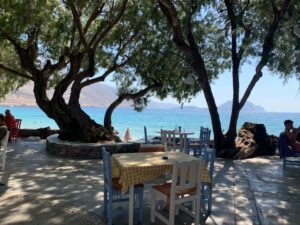
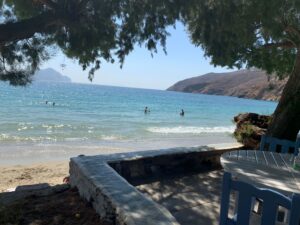
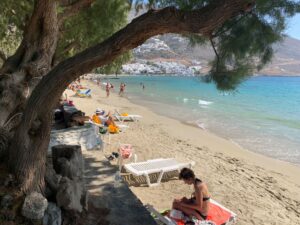
Here is the view from our room
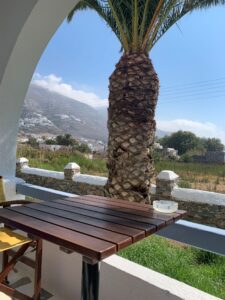
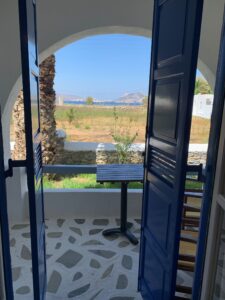
This is the wing of the hotel we were in. I think it is a newer part,
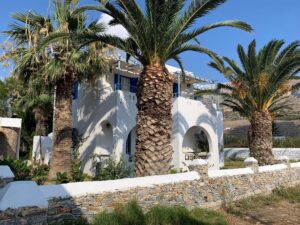
and the swimming pool with a bar. Every comfort! Gianni, Niki’s son, who is bartender, served me homemade ice cream by the pool.
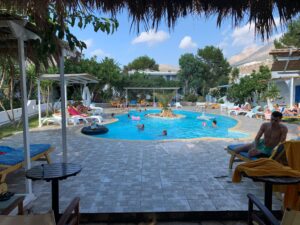
Now onto the creative art by Sofia. Everywhere in the hotel were her sculptures made from natural materials.
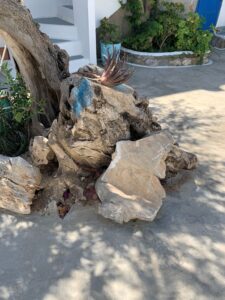
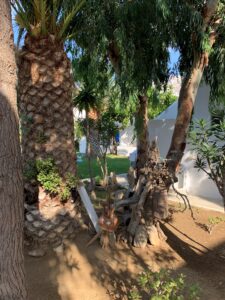
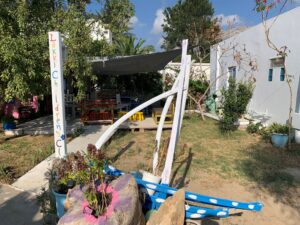
Boats are a theme. There were two at Lakki, but I photographed boats everywhere on Amorgos, both real and models. The one below is a real boat no longer on the water.
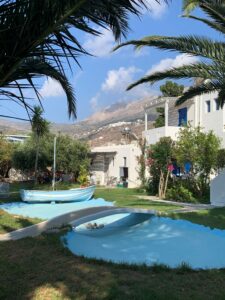
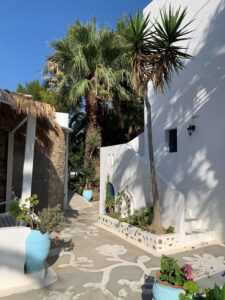
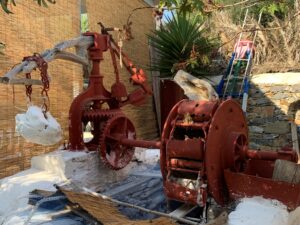
The old waterwheel for bringing up water.
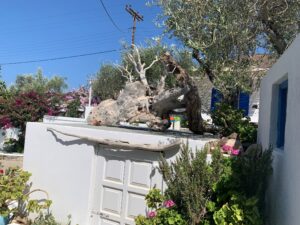
A giant root on top of a door
Everywhere we looked we saw signs of Sofia’s creativity, including in the dining room, where the lamps are painted with a Mondrian design
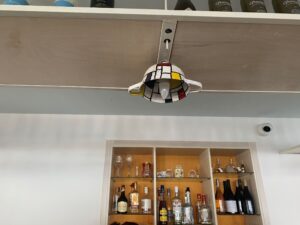
The landscaping was also creative
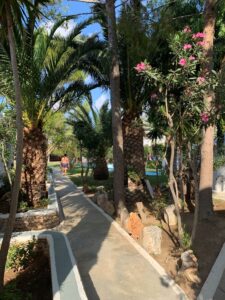
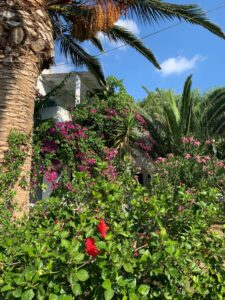
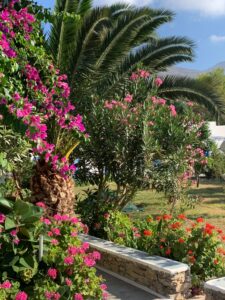
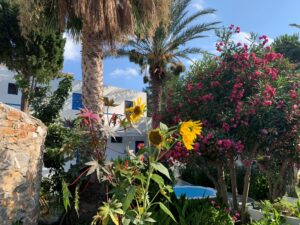
And of course the hospitality is unmatched. And the cooking delicious. Here we are with Henry’s family on our first night
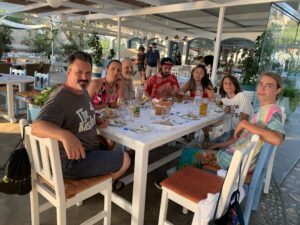
And finally a walk on the beach at sunset with a view of the ferry coming in to the harbor. Since there is no airport on Amorgos, it still nurtures traditional culture often created by families who have been on the island for many generations. The younger generation is transforming those traditions as well, as I mentioned with respect to the music and the shoemaker’s granddaughter in previous posts.
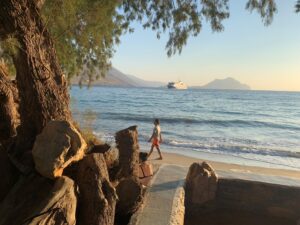
This entry was posted on and is filed under Uncategorized.
Art, Culture, and Small Museums in the Cyclades
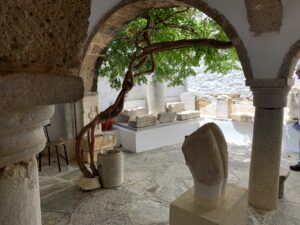
The tiny archeological museums on Amorgos and Naxos were filled with artifacts found on those islands. The intimacy of the spaces, the variety of different types of sculptures, the sense of discovery make visits to these museums delightful.
The first museum that we visited was the Archeological Collection of Amorgos, in the Chora, the old and picturesque capital of the island.
Housed in a former Venetian style mansion, the artifacts documented the long long history of the island. In these photos you see the picturesque courtyard with various artifacts to discover. We even had a guided tour of the inside rooms of the museum!
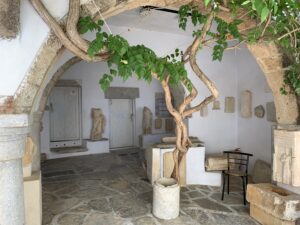
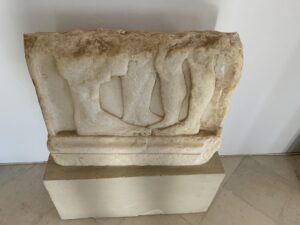
This is a fragment of a late Archaic grave stele carved by an artist from Paros in the late 5th c BC!
Or below is a Roman relief found in the bay of Aigiali Bay at the other end of the island from the museum
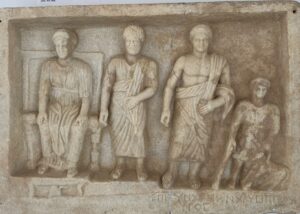
There is even a catalog of the museum by the outstanding excavator Lila Marangou
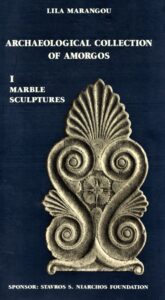
This map shows archeological sites on Amorgos ( hard to see)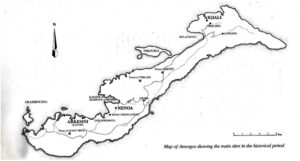
And here is a diagram of a neolitihic site on Amorgos drawn by my sister in law Carolina who lived nearby.
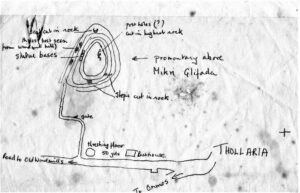
Of course the most famous early Cycladic sculpture of all was found on the island of Keros near Amorgos. It is now in the National Museum in Athens, but there are many versions of it in the small museum on Naxos in their Chora
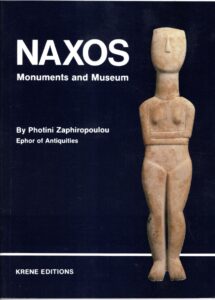
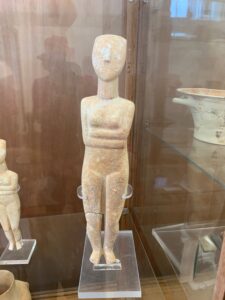
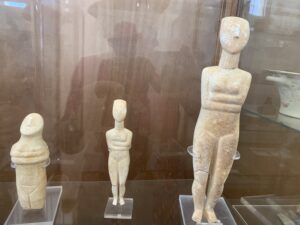
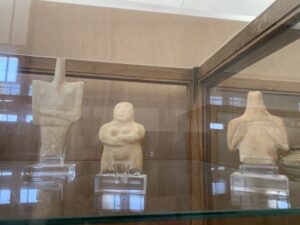
We also saw fragments lined up in an even smaller museum in the village of Apeirianthos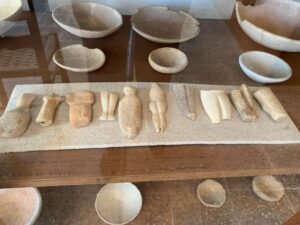
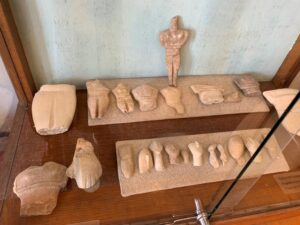
All of these Cycladic women date to 2800 – 2300 BC. ! Their odd pose with arms crossed across their torso perhaps suggests protection. Also odd is that the face only features the nose, no mouth or eyes.
These small museums also had other delights. In the Museum in Naxos we saw many octopus vases, one of my favorite depictions. 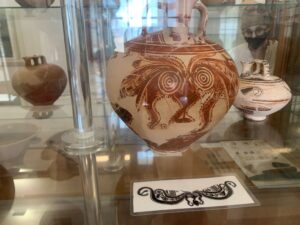
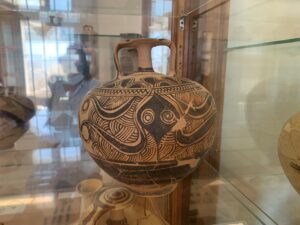
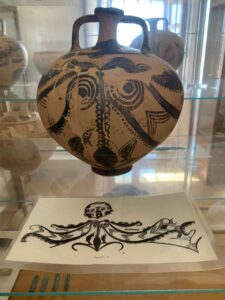
We also saw real octopus in front of restaurants. Comparing them to the vase paintings, I think the one in the middle shows the Octopus organs that appear on the vase. Not sure about the anatomy of the octopus!
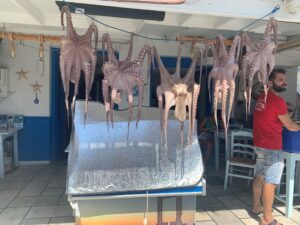
On Naxos we took a tour that allowed us to visit many villages.
Here is the map of the island.
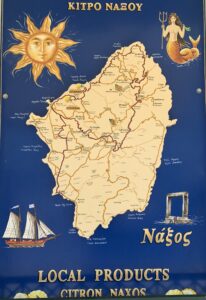
Most exciting for me was the Temple of Demeter, the only temple we saw on the trip.
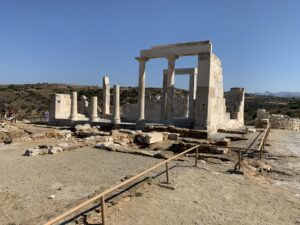
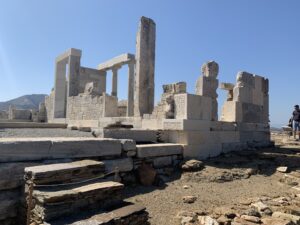
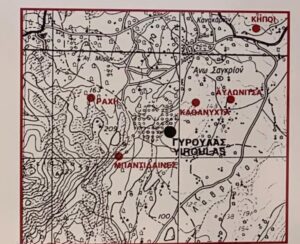
This is a map of the ancient area when the local agricultural people worshipped earth deities such as Demeter on the hill top. They worshipped in the open air with offering pits (brown on the plan.)
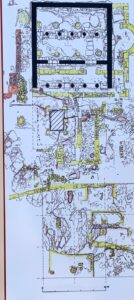
You can see the plan of the marble temple here in black, built in the early 6th c BC when the community became more prosperous. Apparently it is an important example of an early classical ionic temple.
In the early Christian period the temple was converted into a church ( yellow on the plan)
The site was excavated between 1994 – 2000 sponsored by the University of Athens and Munich Polytechnic.
In addition to the temple, there was a small museum which I loved because they took a few pieces and showed us where they went, here on the body of a standing man and below on a pediment.
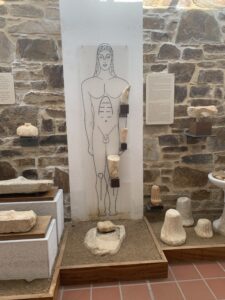
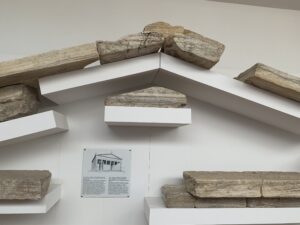
From this stunning temple, we went on to the village of Damalas
where we saw a restored olive press
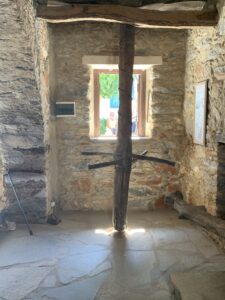
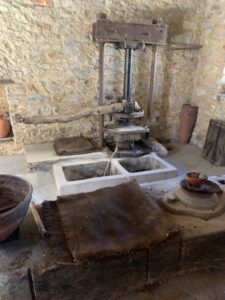
Our guide explained how it all worked. People pulled the spokes that you see in one photo. You also see the actual press and the pits where the olive oil was probably separated from the water.
Next we visited a pottery studio. The owner explained that he was a fourth generation potter and his daughter in the next room was the fifth generation.
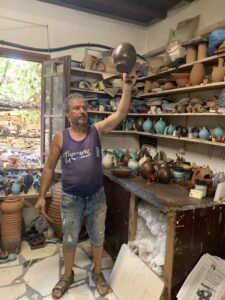 I bought a smaller version of the pot he is holding up, apparently a traditional vessel for drinking wine.
I bought a smaller version of the pot he is holding up, apparently a traditional vessel for drinking wine.
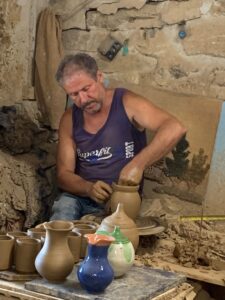
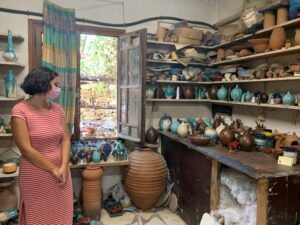
Next a distillery for Kitron, in the village of Chalki. Kitron is a fabulously delicious liquor, I wish we had bought a bigger bottle. They had an intriguing logo of people on a small boat, not sure how that refers to distilling lemons. It was founded in 1896
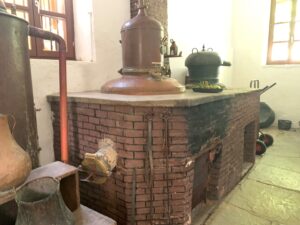
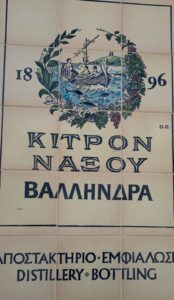
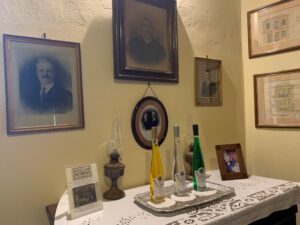
The founders of the brewery and their three elegant types of Kitron.
The next stopping place was Apeiranthos, of the small museum mentioned above. The taverna where we had lunch served amazing local rose wine and local cheeses at our lunch. 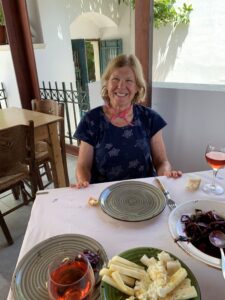
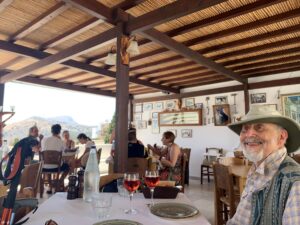
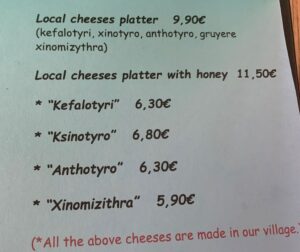
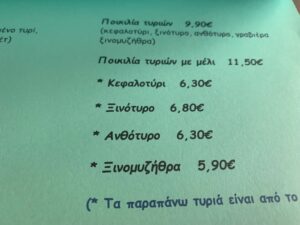
I copied the English and the Greek to practice my Greek.
These cheeses were incredibly delicious.
In the same village was a women’s cooperative preserving traditional patterns and techniques. The Women’s Association of Traditional Art began in 1987. As the brochure says: ” the traditional cloth is woven on a loom ( seen in photo) with great pride, out of respect towards their ancestors who passed on to them this technique practiced centuries ago, but which is still part of their culture today. ”
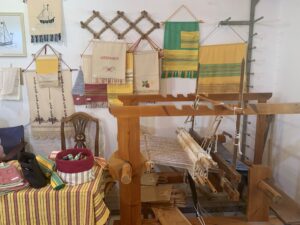
Our last stop was the famous so called Kouros still in the mountain side in Naxos. Although nicknamed a Kouros, it is actually an unfinished statue of Dionysus made in the 6thc BC.
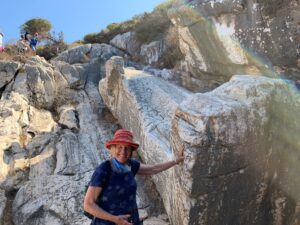
We returned to the main center of Naxos for another wonderful day of walking ancient streets and seeing off beat sites. My favorite discovery was this tiny shop “Micraasia” high up on a path leading to the top of the town. She carries creative items such as ecoprint tee shirts and necklaces made from “happy beads” by contemporary artist Yiorgas Syrigas.
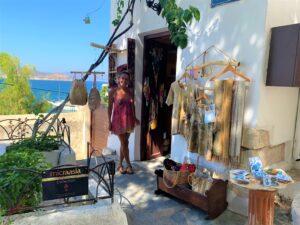
But every street is beautiful in the old city center of Naxos
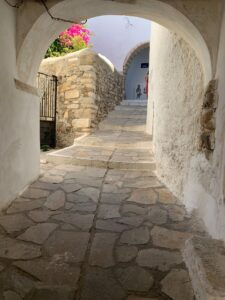
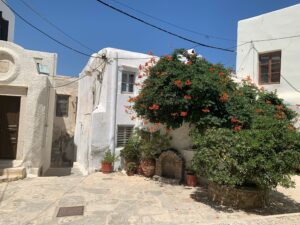
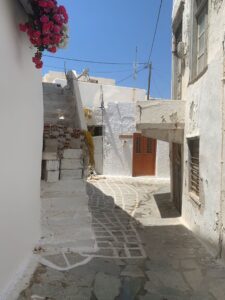
On our last night out in Naxos we ate grilled calamari. Here we are on the way to that dinner.
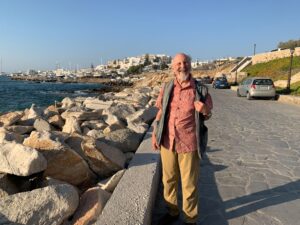
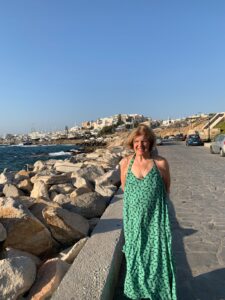
and one last iconic image
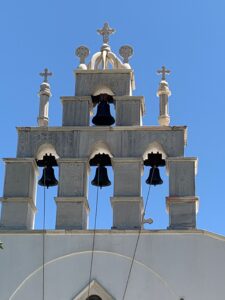
This entry was posted on August 10, 2021 and is filed under Uncategorized.

